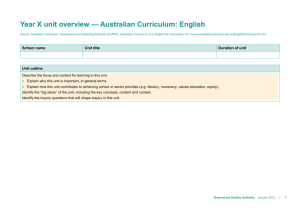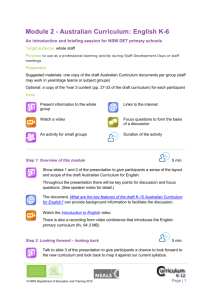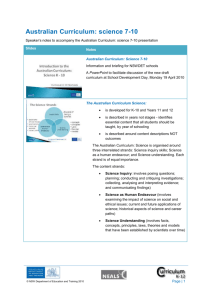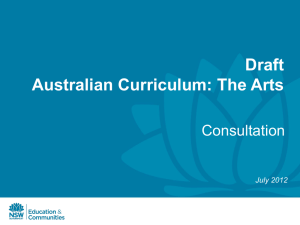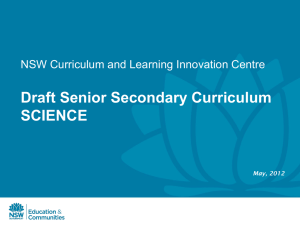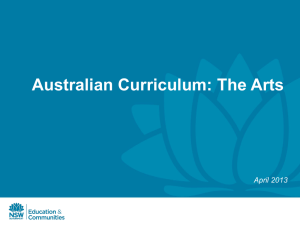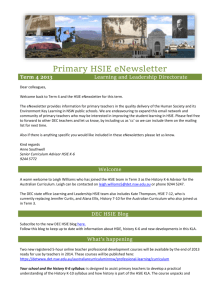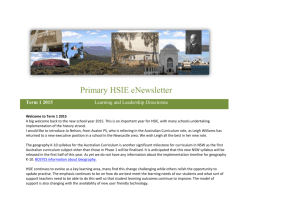Australian Curriculum History K-6
advertisement
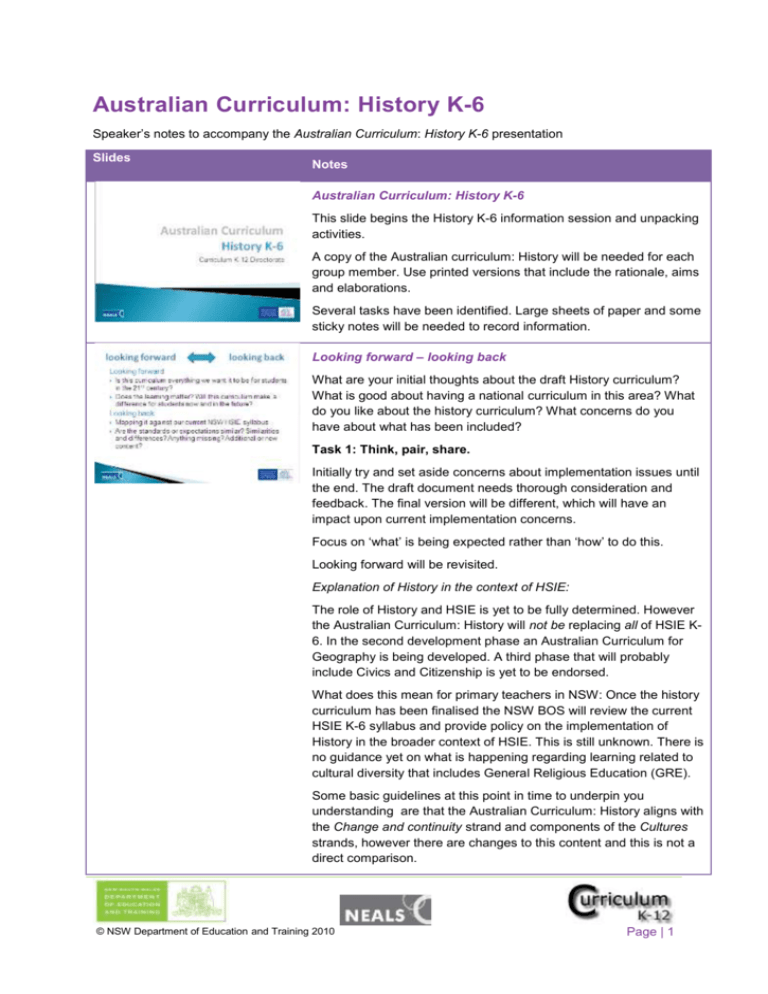
Australian Curriculum: History K-6 Speaker’s notes to accompany the Australian Curriculum: History K-6 presentation Slides Notes Australian Curriculum: History K-6 This slide begins the History K-6 information session and unpacking activities. A copy of the Australian curriculum: History will be needed for each group member. Use printed versions that include the rationale, aims and elaborations. Several tasks have been identified. Large sheets of paper and some sticky notes will be needed to record information. Looking forward – looking back What are your initial thoughts about the draft History curriculum? What is good about having a national curriculum in this area? What do you like about the history curriculum? What concerns do you have about what has been included? Task 1: Think, pair, share. Initially try and set aside concerns about implementation issues until the end. The draft document needs thorough consideration and feedback. The final version will be different, which will have an impact upon current implementation concerns. Focus on ‘what’ is being expected rather than ‘how’ to do this. Looking forward will be revisited. Explanation of History in the context of HSIE: The role of History and HSIE is yet to be fully determined. However the Australian Curriculum: History will not be replacing all of HSIE K6. In the second development phase an Australian Curriculum for Geography is being developed. A third phase that will probably include Civics and Citizenship is yet to be endorsed. What does this mean for primary teachers in NSW: Once the history curriculum has been finalised the NSW BOS will review the current HSIE K-6 syllabus and provide policy on the implementation of History in the broader context of HSIE. This is still unknown. There is no guidance yet on what is happening regarding learning related to cultural diversity that includes General Religious Education (GRE). Some basic guidelines at this point in time to underpin you understanding are that the Australian Curriculum: History aligns with the Change and continuity strand and components of the Cultures strands, however there are changes to this content and this is not a direct comparison. © NSW Department of Education and Training 2010 Page | 1 The consultation process for primary teachers is somewhat difficult as it becomes necessary to second guess what else might need to be included from other aspects of the social sciences / HSIE that underpin the history ( and geography / civics and citizenship) learning. Content descriptions Using Year 3 as an example of what the content descriptions across all two look like. CLICK - Each year includes a Preface that indentifies the big idea(s) that is being addressed in that year, there is a brief statement that describes what students learn about in this year. CLICK - Several broad inquiry questions are identified. Do these questions reflect the content descriptions? CLICK - The content descriptions are numbered (like our outcomes, but do not read as outcomes). The content descriptions are organised into 2 strands. Knowledge and understandings for each year K-6; Skills are in two year bands that align with our current stages of learning, i.e. K-2, 3-4, 5-6. Depth studies, which are the headings in the Knowledge and understanding strand are identified for each year e.g. As you can see in Year 3 there is ‘Our community’ and also ‘We remember’. Within each of these depth studies there may be one or more topics or units of work. Knowledge and understanding includes personal, family, local, state, national, regional and world history. There is an increasing emphasis on Australian history in its world history context. Historical understanding is developed through a range of disciplinary concepts inherent to the discipline of history including evidence, continuity and change, cause and effect, significance, empathy, perspectives and contestability. These skills are organised using the process of historical inquiry associated with: historical questions and research; the analysis and use of sources; perspectives and interpretations (years 3 – 6 only); comprehension and communication. There is an increasing emphasis on historical interpretation and the use of evidence within the skills strand. CLICK The elaborations are examples or illustrations of the content, but are not intended to be comprehensive content points. Each year level then has achievement standards. Task 2: review the years in a stage or a single year that you are most familiar with. Examine the content descriptions of the Australian Curriculum: History for an overall initial impression develop a same / different chart using sticky notes. © NSW Department of Education and Training 2010 Do the skills support the knowledge and understanding? Any comments about the expectations of students (and teachers)? Page | 2 Big picture issues Big picture issues: Is there a clear and logical scope and sequence of learning that can be implemented in a typical primary classroom? Do the content descriptions assume prior knowledge, specific information or skills that have not been reasonably included in previous year descriptions, or are outside? Task 3: Undertake a PMI Begin to develop a group PMI as a forum for recording the plus, minus and interesting points of the history curriculum related to the conceptual scope and student learning related to their development. Year levels Focus on including information about these questions on the PMI. These additional questions may be of assistance: Can you identify similarities and differences to what you are doing now? For knowledge and understanding and skills? How long do you spend on teaching the history that has been included in the current HSIE syllabus? Can you identify the time differences between what you are doing now compared to the time you would need to spend to teaching the draft curriculum? Achievement standards Task 4: Order the achievement standards Use the attached handout to examine the achievement standard statements for each year. These are out of year order. Order these achievement standard statements in correct year order. Correct order: first row is Kindergarten, Year 2, Year 1. Second row is Year 4, Year 3, Year 6, Year 5. Is there are clear progression of learning K-6 clearly expressed in the achievement standards for the draft history curriculum? Additional discussion and feedback Use the information recorded on the Same / Different chart and the PMI chart to unpack the group’s findings on the Australian curriculum: History. If time permits develop some staff discussion on the two questions listed in relation to history. © NSW Department of Education and Training 2010 How will this curriculum make a difference for students now and in the future? Is this curriculum everything we want it to be for students in the 21st century? Page | 3 © NSW Department of Education and Training 2010 Page | 4

